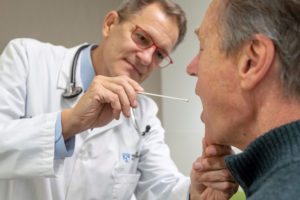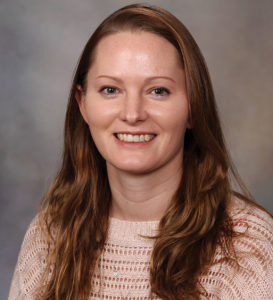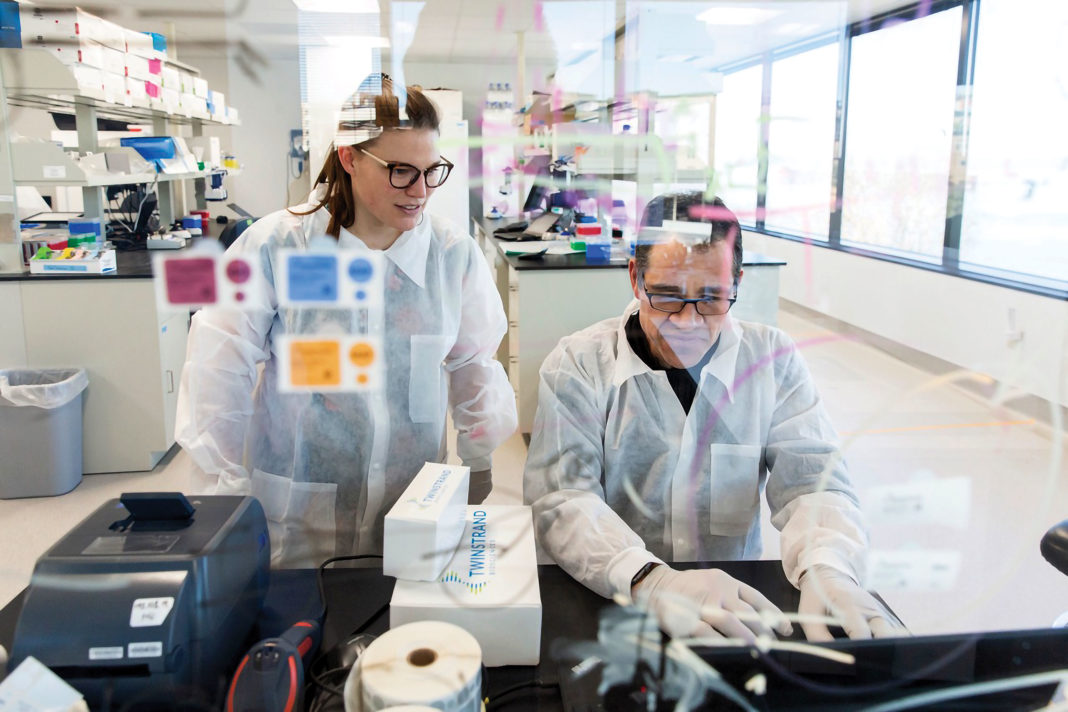If the newly formed relationship between genomics and medicine is to thrive, it needs what every relationship needs: good communication. In some respects, communication is about agreeing on unambiguous technicalities—matters such as instrument specifications, costs, processing speeds, application options, and so on. In other respects, communication is about meaning. Somehow, sequencing information must be obtained, analyzed, interpreted, shared, and understood.
The information flow may appear to be a one-way affair, but it isn’t. The nature of the flow is sensitive to the information needs of physicians and patients, the downstream parties in genomic medicine. In other words, the upstream parties, the genomic experts, must avoid communication breakdowns or bottlenecks if genomic medicine is to succeed as a market segment and as a treatment modality. All parties, upstream and downstream, need to listen to and cooperate with each other to ensure that genomic medicine improves patient outcomes.
Speed dating
There is no shortage of company announcements that their sequencing platforms are faster, smaller, cheaper. Look no further than Illumina’s unveiling of its new machines, the NextSeq 1000 and NextSeq 2000, at a recent J.P. Morgan Healthcare Conference. The company indicates that these machines are meant to support the growing demand for clinical-grade genomic information at lower cost.
Just before the J.P. Morgan event, during a conference call organized for investors, Illumina president and CEO Francis A. deSouza said, “NextSeq 2000 offers “higher output, greater ease of use, greater breadth of applications, and all at lower sequencing cost.”
Keith Robison, PhD, long-time genomics blogger, tells GEN that Illumina is positioning the NextSeq 2000 for “clinical markets where absolute speed is not critical.” He notes that the clinical sequencing market has become used to long turnaround times. Although speed would be a plus for many applications, he continues, “the NextSeq isn’t going to provide that.” Robison adds, “In the case of an intensely ill child in a neonatal intensive care unit, the NextSeq would represent a big step backward on turnaround time vs. the
HiSeq 2500 in rapid-run mode.”
“All of these advancements will help make inroads, but the NextSeq isn’t a game changer,” maintains Shawn Baker, PhD, co-founder of AllSeq and a genomics advisor and consultant at SanDiegOmics.com. Baker tells GEN that there are faster and cheaper select per sample) machines already available, adding that a diagnostic version of the new NextSeq would help smaller labs.
Will the smaller, cheaper platforms—for example, the new platform being launched by GenapSys—be a game changer in clinical genomics? “I doubt it,” states Baker. It could be useful in point-of-care settings, he suggests, but “there aren’t too many applications that benefit that much from the quick turnaround time of point of care.” One application where Baker can see a use for something small and quick is in infectious disease testing.
Robison reinforces this point by citing the “amazingly fast identification and sequencing” of the coronavirus in China. The ease and speed of analysis, he says, highlights the difficulties researchers had when the AIDS epidemic broke. Back then, when sequencing was low throughput, two years passed between the discovery and the sequencing of HIV-1. Even though technology had improved by the time SARS hit in 2003, sequencing of the virus took a month. Now, Robison says, it could be done in a week.
Another area where speed is crucial to success is the sequencing that permits the diagnosis of pediatric idiopathic genetic diseases. Such sequencing is carried out at Rady Children’s Institute for Genomic Medicine, where Stephen Kingsmore, MD, performs a 24-hour whole genome analysis for critically ill newborns. There, Baker notes, clinicians need quick turnaround times so sequencing results can inform treatment decisions as soon as possible.
Clinical availability
Bringing genomics into medicine is full of challenges, says Benjamin Solomon, MD, head of the clinical research program at the National Human Genome Research Institute select NHGRI). “There are,” he insists, “bottlenecks all along the way.”

According to Solomon, genomic testing is not the best option for every single condition or every single person, but there are clinical situations where it makes a lot of sense. With these situations in mind, he tells GEN that if genomic medicine is to succeed, it must “make rapid diagnosis much, much, much more broadly available.”
Solomon draws a comparison to a child with a suspected biochemical condition of inborn errors of metabolism. The biochemical tests, he notes, are straightforward to order and capable of being done quickly and regularly. “Ordering a rapid biochemical test is not as big of a deal as ordering a rapid exome or genome test,” he explains. In contrast, navigating the logistics of genetic testing can be tricky. So, he adds, “if we can move sequencing toward the type of accessibility and speed seen in other tests, that would be phenomenal.” He adds, however, that this means making sure that geneticists and nongeneticists are more aware of these tests, which takes education and training.
Baker agrees that physician education is perhaps the primary element that would “move the needle” for genomic medicine. “Most clinicians don’t know enough about clinical genomics to use it routinely,” he says. “And when they do, getting the tests reimbursed can be a real struggle.”
Baker adds that the genomic diagnostics companies need to demonstrate their value to reimbursement agencies, a task that would be easier if a plausible case could be made for reducing overall healthcare costs. The value of genomic medicine is becoming clearer—for example, in applications such as noninvasive prenatal testing—but there’s a lot of progress to be made.
Disparate reads
Will longer reads make a meaningful change in the clinic? “Right now, I would like to see long-read technology become more accessible and affordable,” notes Bruce Korf, MD, PhD, the associate dean for genomic medicine at the University of Alabama at Birmingham. He adds that long reads have the potential to “significantly increase diagnostic yield.”

Jesse Salk, MD, PhD
Jesse Salk, MD, PhD, an oncologist at the Fred Hutchinson Cancer Center and the CEO of TwinStrand Biosciences, does not necessarily agree. He tells GEN that even though long reads are “neat from research perspective,” they are “not a real make-or-break on clinical translation” outside a few very niche clinical applications.
“It’s an open question right now,” adds Robison. “I’m unaware of a clinical application where people have shown that ultralong reads are important.” Even in nucleotide repeat disorders, he explains, “you need tens of kilobases tops. You don’t need hundreds of kilobases.”
Baker agrees that long reads “won’t move the needle anytime soon—and won’t until they show more clinical utility, which will take time.” It’s a bit circular, he admits, as short-read technologies have been used both for discoveries and for diagnostics. Once long reads make more discoveries—in clinically relevant structural variants, repeats, etc.—then they may be needed for the diagnostics.
In Salk’s opinion, the most important technical improvement is not throughput, read length, or speed, it is accuracy. He explains that reducing the background errors reduces the complexity of data analysis drastically. Ultimately, improving accuracy eases data interpretation.
Meaningful connections
It is important to recognize the distinction between the technology for sequencing a genome, and the technology for interpreting the genome, insists Robert C. Green, MD, professor of medicine at Harvard Medical School and the director of the Genomes2People select G2P) research program. Over the past 20 years, the technology for sequencing has attracted a lot of attention. And what are the consequences? “In our conversations with patients, the media, and even among ourselves,” Green asserts, “we tend to give shorter shrift to the interpretation of the genome.”
“When you’re talking about sequencing,” he continues, “you have to talk about the interpretative process,” where relevant matters include the number of genes to be analyzed, whether a trained molecular geneticist is involved, and whether curation should be conducted manually.

Robert C. Green, MD, professor of medicine at Harvard Medical School, leads the Preventative Genomics Clinic at the Brigham and Women’s Hospital—the nation’s first academic clinic to offer comprehensive DNA sequencing and genetic risk assessments to healthy adults, assessments that can predict select and even prevent) the onset of disease. [Len Rubenstein]
Beyond sexiness
“There are simple things that are much less ‘sexy’ than some technological advances,” Salk says, “but they are really far more important.” In addition to data interpretation, such things include ease of being able to order a test, not having to fight for reimbursement, and having easy ways of getting reports into medical records.
“I see the biggest challenges now being like what it was with early computers,” Salk continues. “It wasn’t that the computers didn’t work, it was that the average person couldn’t approach them. I’m not going to try to teach my grandmother to use command line programing, but she can easily pick up and learn how to use an iPhone.”
Although the new sequencing machines look as sleek as an iPhone, they aren’t user-friendly. Getting them to perform data processing chores still requires advanced computer skills. Instead of focusing on new devices, Salk suggests, perhaps through better interfaces.
True intimacy
Genetics, long the province of rare disease, is becoming more and more salient to everyday medicine. We are moving beyond indication-based testing, Green suggests. We are starting to hear more and more about preventive genomics. That is, instead of figuring out what has already gone wrong, we can look for signals that help us predict what might go wrong in the future. Green cites the example of polygenic risk scores. They can be used to identify the small percentage of people who are at a significantly higher risk of, for example, heart disease.
“If we had talked about breast cancer 10 years ago,” Solomon points out, “we would have been aware of only a few genes.” But growing complexity brings more options. “More of the testing is shifting to larger panels, or even to whole exomes or genomes,” he adds.

Cherisse A. Marcou, PhD
Whole exome sequencing select WES union which sequences approximately 1–2% of the genome, provides “a clinically useful mechanism to identify disease causing variants” notes Cherisse A. Marcou, PhD, co-director of the clinical cytogenetics laboratory at the Mayo Clinic. However, Marcou explains, WES does not capture all types of variation that cause genetic disorders. For this reason, whole genome sequencing select WGS) is emerging as a possible replacement test that can capture nearly all clinically relevant genomic variation.
WGS allows for the interrogation of significantly more regions of the genome than WES, such as non-coding regions. Consequently, “continued research collaborations, publications, and data-sharing” are necessary to aid in the interpretation of variants identified by sequencing maintains Nicole Hoppman, PhD, Marcou’s colleague and co-director of the clinical cytogenetics laboratory at the Mayo Clinic. These measures, coupled with functional assays such as RNASeq and iPS cell characterization, will reduce the number of variants of uncertain significance returned to patients.

Nicole Hoppman, PhD, Mayo Clinic
Genomic medicine, then, is becoming more comprehensive, more established. But it’s not just “settling in.” It’s in a constant state of flux. Genomic scientists and clinicians are finding that a constant give and take is needed if they are to use sequencing information to improve patient outcomes.
The Next Genomics Era: Focus on Access and Actionability
Fueled by advances in technology, declines in the cost of sequencing, and an increase in our understanding of the genome, a new era in genomics is unfolding. While there has been tremendous progress in how genomic data is interpreted, there has been less on making it accessible and actionable for providers and their patients.
Today, for example, millions of Americans are living at an increased risk for highly actionable hereditary conditions, including heart disease and cancer.1 Research shows that 90% of these people are likely unaware of this risk as they do not meet guidelines for genetic testing and thus are unable to take advantage of potentially lifesaving interventions.
To address this gap, an increasing number of health systems are launching large-scale genetic screening initiatives, including Renown Health’s Healthy Nevada Project, AdventHealth’s WholeMe, and Mayo Clinic’s Tapestry select all of which are working with Helix, a population genomics company that provides whole exome sequencing and return of results for the initiatives). Through the efforts of these health systems and others like them, millions of seemingly healthy individuals will soon be sequenced.
Initial results from the Healthy Nevada Project reported in a preprint article with Helix that is currently under peer review2 demonstrated the potential impact of these initiatives, including that:
- 1:80 participants were carriers of pathogenic or likely pathogenic variants across three hereditary conditions: familial hypercholesterolemia, hereditary breast and ovarian cancer syndrome, and Lynch syndrome;
- 26% of these carriers had already begun to develop symptoms of disease;
- 90% of the carriers did not meet medical guidelines for genetic testing and were thus unaware of their increased risk;
- carriers showed a 30-year acceleration of disease relative to noncarriers.
References
1. CDC. Tier 1 Genomics Applications and Their Importance to Public Health. Accessed February 2020.
James Lu, MD, PhD, is co-founder and CSO of Helix.
Small RNAs Are Playing a Big Role in Biomarker Discovery
Small RNAs—specifically, microRNAs—are important regulators of many cellular processes including survival, proliferation, and differentiation. They have multiple roles in gene regulation and are differentially regulated in many diseases. MicroRNAs are also secreted into cell-free fluids, where they exist in stable forms. MicroRNA expression can be altered during disease progression, which makes qualitative and quantitative assessment of circulating microRNAs a potential tool to identify the initiation and progression of diseases. MicroRNAs, then, are being evaluated as biomarkers for many different applications, from screening for cancer to predicting the success of liver transplantations. Next-generation sequencing select NGS) is a valuable tool for microRNA analysis as it can capture many complex isoforms that other technologies may miss, according to Arvind Kothandaraman, general manager, NGS, PerkinElmer.
“When NGS is being considered for microRNA studies, users should pay close attention to simplification of microRNA isolation and library preparation, mitigation of ligation-associated bias, and sample availability,” he says. “These factors play a critical role in the evolution of microRNAs as a tool for routine use in clinical settings.”
Currently, considerable effort is being devoted to identifying suitable extracellular microRNAs for use as noninvasive biomarkers of many diseases, notes Kothandaraman. “Many recent studies have focused on comparing existing small RNA library prep kits and protocols to identify methods delivering low bias and consistent results,” he adds. “With the research going into using microRNA as biomarkers, small RNAs are poised to play a big role as a tool for diagnosis, prognosis, therapy response monitoring, and disease tracking.”


